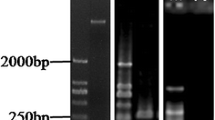Abstract
Lycopersicon peruvianum (wild tomato) is a gametophytic self-incompatible (SI) species. One natural population has been shown to harbor a self-compatible (SC) allele. A stylar protein associated with the self-compatibility allele has been elucidated using SDS-PAGE. The temporal and spatial expression of this protein is presented and compared with protein expression of two SI alleles. Hybrids containing the SC and SI alleles were used in a backcrossing program to introgress the SC allele into SI backgrounds in six independent lines. Controlled pollinations and SDS-PAGE were used to identify and select classes of progeny. After four backcross generations (approximately 97% recovery of the SI backgrounds) the SC allele still confers self-fertility in lines that contain this allele, providing evidence that the mutation to SC occurred at the S-locus and that the associated protein is likely responsible.
Similar content being viewed by others
References
Ai Y, Kron E, Kao T-H (1991) S-alleles are retained and expressed in a self-compatible cultivar of Petunia hybrida. Mol Gen Genet 230:353–358
Bernatzky R (1993) Genetic mapping and protein product diversity of the self-incompatibility locus in wild tomato (Lycopersicon peruvianum). Biochem Genet 31:173–184
Bernatzky R, Miller DA (1994) Self incompatibility is codominant in intraspecific hybrids of self-compatible and self-incompatible Lycopersicon peruvianum and Lycopersicon hirsutum based on protein and DNA marker analysis. Sex Plant Reprod 7:297–302
Gradziel TM, Robinson RW (1989) Breakdown of self incompatibility during pistil development in Lycopersicon peruvianum by modified bud pollination. Sex Plant Reprod 2:38–42
Hogenboom NG (1972a) Breaking breeding barriers in Lycopersicon. 2. Breaking self incompatibility in Lycopersicon peruvianum (L.) Mill. Euphytica 21:228–243
Hogenboom NG (1972b) Breaking breeding barriers in Lycopersicon. 3. Inheritance of self compatibility in L. peruvianum (L.) Mill. Euphytica 21:244–256
Hogenboom NG (1972c) Breaking breeding barriers in Lycopersicon. 1. The genus Lycopersicon, its breeding barriers, and the importance of breaking these barriers. Euphytica 21:221–227
Laemmli UL (1970) Cleavage of structural proteins during assembly of the head of bacteriophage T4. Nature 227:680
Mau SL, Williams EG, Atkinson A, Anderson MA, Cornish EC, Greco B, Simpson RJ, Kheyr-Pour A, Clarke AE (1986) Style proteins of wild tomato (Lycopersicon peruvianum) associated with expression of self incompatibility. Planta 169:184–191
McClure BA, Haring V, Ebert PR, Anderson MA, Simpson RJ, Sakiyama F, Clarke AE (1989) Style self-incompatibility gene products of Nicotiana alata are ribonucleases. Nature 342:955–957
Nettancourt D de (1977) Incompatibility in angiosperms. Springer, New York Berlin Heidelberg
Rick CM (1963) Barriers to interbreeding in Lycopersicon peruvianum. Evolution 17:216–232
Rick CM (1982) A new self-compatible wild population of L. peruvianum. Rep Tomato Genetics Coop 32:43–44
Rick CM (1986) Reproductive isolation in the Lycopersicon peruvianum complex. In: D'Arcy WG (ed) Solanaceae biology and systematics. Columbia University Press, New York
Rivers BA, Bernatzky R, Robinson SJ, Jahnen-Dechent W (1993) Molecular diversity at the self-incompatibility locus is a salient feature in natural populations of wild tomato (Lycopersicon peruvianum). Mol Gen Genet 238:419–427
Tanksley SD, Loaiza-Figueroa F (1985) Gametophytic self-incompatibility is controlled by a single major locus on chromosome 1 in Lycopersicon peruvianum. Proc Nat Acad Sci USA 82:5093–5096
Thompson RD, Uhrig H, Hermsen JG, Salamini F, Kaufmann H (1991) Investigation of a self-compatible mutation in Solanum tuberosum clones inhibiting S-allele activity in pollen differentially. Mol Gen Genet 226:283–288
Author information
Authors and Affiliations
Rights and permissions
About this article
Cite this article
Rivers, B.A., Bernatzky, R. Protein expression of a self-compatible allele from Lycopersicon peruvianum: introgression and behavior in a self-incompatible background. Sexual Plant Reprod 7, 357–362 (1994). https://doi.org/10.1007/BF00230514
Received:
Accepted:
Issue Date:
DOI: https://doi.org/10.1007/BF00230514




